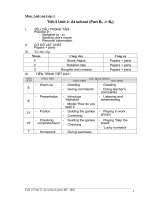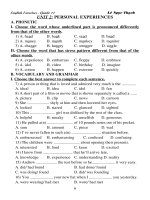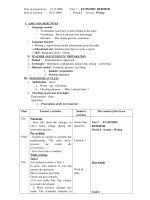unit 2 writing
Bạn đang xem bản rút gọn của tài liệu. Xem và tải ngay bản đầy đủ của tài liệu tại đây (293.36 KB, 13 trang )
Unit 2: Exercise 1
Look at the pie charts. Then complete the missing information in the pie charts
and the key. Use the numbers in the box.
2,131
26
A
B
C
5,268
6.5
D
Unit 2: Exercise 2
When comparing two charts, you need to carefully choose the most important
information.
Look for high numbers, low numbers and equal numbers.
Remember to look for trends and patterns.
Look for noticeable differences.
Look at the sentences and decide what type of information they give.
This is a key pattern as other numbers changed.
This is a key trend. This is a large
increase.
This is not a key piece of information – small changes are not significant.
This is not true – the percentage change was 7.2%.
This is not true – women in full-time
employment was the greatest percentage change.
This is the highest number of
employees in all the groups represented.
This is the most significant change.
This represents a key point – smallest and largest numbers are important.
1. All the numbers increased.
_____________________________________________________________________
2. Women in full-time employment rose by 3,214,000.
_____________________________________________________________________
3. Women working full-time increased by over 8%.
_____________________________________________________________________
4. The number of men in full-time employment was greatest in both years.
_____________________________________________________________________
5. The number of women in part-time employment rose very slightly.
_____________________________________________________________________
6. The greatest percentage change was in men working full-time.
_____________________________________________________________________
7. 26% of workers in 2012 were women in full-time employment.
_____________________________________________________________________
8. Men working part-time was the smallest percentage in each year.
_____________________________________________________________________
9. 13,794,000 men were working full-time in 2012.
_____________________________________________________________________
Unit 2: Exercise 3
Look at the charts. Then put the sentences in the correct order to complete the
paragraph.
The pie charts show the numbers and percentages of men and women in both full-time and
part-time employment in the UK in 1988 and 2012.
Overall, we can see that all numbers increased but there were significant differences in the
proportions for each year.
These changes can be seen in the percentages of the total workforce; in 1988, women in fulltime employment made up only 18.8% of working people, but this increased to 26% in 2012.
As well as the number of people working full-time, the number of people working part-time
also increased, with women being the largest number in both years: 5,268,000 and 5,979,000,
compared with 1,550,000 and 2,131,000 for men.
Firstly, although the number of men in full-time employment was largest in both years, the
greatest change was in the number of women working full-time. This increased from
4,482,000 in 1988 to 7,696,000 in 2012.
In conclusion, apart from female full-time employment and male part-time employment,
percentage figures decreased between the two years. Most significantly, men working fulltime dropped below 50% to 46.6% in 2012.
1.
2.
3.
4.
5.
6.
Unit 2: Exercise 4
It’s important to understand the information given and present the facts in a
clear way.
Each sentence from the report covers one topic. Match the topics with the
sentences.
Details of full-time employment figures.
Details of part-time employment figures.
Details of the percentage of women working full-time.
General description of the charts.
General information about the overall trends.
Overview of the information in the charts.
1. ____________________________________________________________
The pie charts show the numbers and percentages of men and women in both full-time and
part-time employment in the UK in 1988 and 2012.
2. ____________________________________________________________
Overall, we can see that all numbers increased but there were significant differences in the
proportions for each year.
3. ____________________________________________________________
Firstly, although the number of men in full-time employment was largest in both years, the
greatest change was in the number of women working full-time. This increased from
4,482,000 in 1988 to 7,696,000 in 2012.
4. ____________________________________________________________
As well as the number of people working full-time, the number of people working part-time
also increased, with women being the largest number in both years: 5,268,000 and 5,979,000,
compared with 1,550,000 and 2,131,000 for men.
5. ____________________________________________________________
These changes can be seen in the percentages of the total workforce; in 1988, women in fulltime employment made up only 18.8% of working people, but this increased to 26% in 2012.
6. ____________________________________________________________
In conclusion, apart from female full-time employment and male part-time employment, all
the other percentage figures decreased between the two years. Most significantly, men
working full-time dropped below 50% to 46.6% in 2012.
Unit 2: Exercise 5
Match the words with the definitions.
A chart
a figure
a percentage
a trend
an owerview
1. an amount expressed in numbers:
2. a short description which provides general information about
something:
3. a general development or change in a situation:
details
4. an amount of something, expressed as a number out of 100:
5. a drawing that shows information in a simple way, often using
lines and curves to show amounts:
6. pieces of information about something:
Unit 2: Exercise 6
Complete the introduction. Use the words in the box. You won’t need to use all
the words.
Firstly
Overall
decreased
details
figures
number
pie charts
proportion
increased
significantly
largest
The ______________ show employment _____________for both men and women in the
UK for the years 1988 and 2012. _____________ , the number of people in work
_____________ in that period, but the _____________of working women rose most
_____________ .
Unit 2: Exercise 7
Read the information. Then look at the sentences. Select the word in each
sentence that matches the definition.
When comparing two charts, we need to find which numbers you can compare because they
are similar and which numbers you can contrast because they are different. Examples of this
are high and low numbers, and numbers which show little or no change.
1. looking or being almost, but not exactly, the same (adjective):
The percentages of women working part-time are similar.
2. (referring to) two people or things together (quantifier):
The numbers for both men and women in employment increased.
3. describing everything together (quantifier):
All numbers rose between 1988 and 2012.
4. an obvious difference between two or more things (noun):
In 1988, there were 12,539,000 men working full time, in contrast only 1,550,000 were parttime.
5. important or noticeable (adjective):
There was a significant increase in women working full-time.
6. small in amount or degree (adjective):
We can see a slight increase in men working part-time.
7. exactly the same, or very similar (adjective):
The pie charts show identical information for 1988 and 2012.
8. compared with the fact that; but (conjunction):
The percentage of women working full-time increased, whereas for men it decreased.
Unit 2: Exercise 8
When you describe the information in two charts, you need to look for figures
and facts that are the same or different.
Look at the sentences and put them into the correct columns.
All numbers rose between 1988 and 2012.
The percentage of women working full-time increased, whereas for men it decreased.
The numbers for both men and women in employment increased.
The percentages of women working part-time are similar.
There was a significant increase in women working full-time.
In 1988, there were 12,539,000 men working full-time, in contrast only 1,550,000 were parttime.
We can see a slight increase in men working part-time.
The pie charts show identical information for 1988 and 2012.
figures/facts that are the same (or nearly the
same)
figures/facts that are figures/facts that are
Unit 2: Exercise 9
Look at the bar charts. Then choose the best words for the gaps.
All
Both
contrast
identical
significant
similar
slight
whereas
1. The percentage of men in employment was ____________ in both years.
2. _______________ the percentages rose between the two years.
3. Women in _______________ to men showed much lower employment rates in all
countries.
4. The employment rate for Japanese men showed a ______________ increase.
5. The pattern was ______________ for all countries – an increase in percentages.
6. ______________ men and women were working more in 2015.
7. Numbers of Japanese and Australian working women increased greatly, ______________
in Ireland the change was smaller.
8. There was a ______________ gap between men and women in Japan in both years.
Unit 2: Exercise 10
WRITING TASK 1
You should spend about 20 minutes on this task.
The bar charts below show the percentages of men and women in employment in three
countries in 2005 and 2015.
Summarise the information by selecting and reporting the main features, and make
comparisons where relevant.
Write at least 150 words.
Please add text into the Student post.
Student post:









